13 Most Important Types of Sales Enablement Content
The significance of content cannot be overstated, here are 13 most important sales enablement content types with examples
The significance of content cannot be overstated, It establishes connections among individuals and teams, culminating in the conversion of potential customers into actual patrons.
Yet, a prevalent challenge persists – businesses often struggle to unlock the full potential of their existing content, leading to missed opportunities.
Especially in B2B content cannot afford to remain isolated; it must seamlessly traverse through various teams, from its inception by marketing teams to its utilization by sales teams, and ultimately reaching its external destination – the target audience.
This is where the concept of sales enablement and content optimized for sales enablement comes into play.
Sales enablement content encompasses strategically crafted materials that empower sales teams to effectively engage with prospects, providing them with the information and resources needed to deliver an optimal experience.
It goes beyond traditional marketing content, tailoring resources specifically for the sales process, addressing the unique needs and challenges faced by sales representatives.
What is sales enablement content?
Sales enablement content is strategic information created to provide sales teams with the resources they need to engage and convert prospects successfully.
This encompasses presentations, guidelines, case studies and more. It primarily helps sales teams by giving them relevant and engaging content, boosting their ability to educate, convince, and eventually generate successful client conversions.
Coordinate Your Sales and Marketing Efforts
Major Challenges Of B2B Content:
Let us now understand what is causing businesses to miss valuable opportunities. Here are three prime causes that we have identified:
Inability to Measure Content Performance:
Marketers are Unable to Measure ROI on Content Assets Content marketers strive to create content assets that are relevant, timely, and contextual to the sales discussion.
But, they are unable to measure the utility of content assets, their effectiveness in closing a sales deal.
In the absence of a reliable methodology to track prospect engagement with content assets and the content mix that sales reps use for customer conversations, marketers rely on their gut feel.
This could lead to Marketers being Unable to Relate to a Customer's Challenge.
But this issue can be easily overcome by the application of a good sales enablement software in place, it will help with tracking the performance of the content and helps in empowering the marketer with the knowledge of what content works and what doesn't.
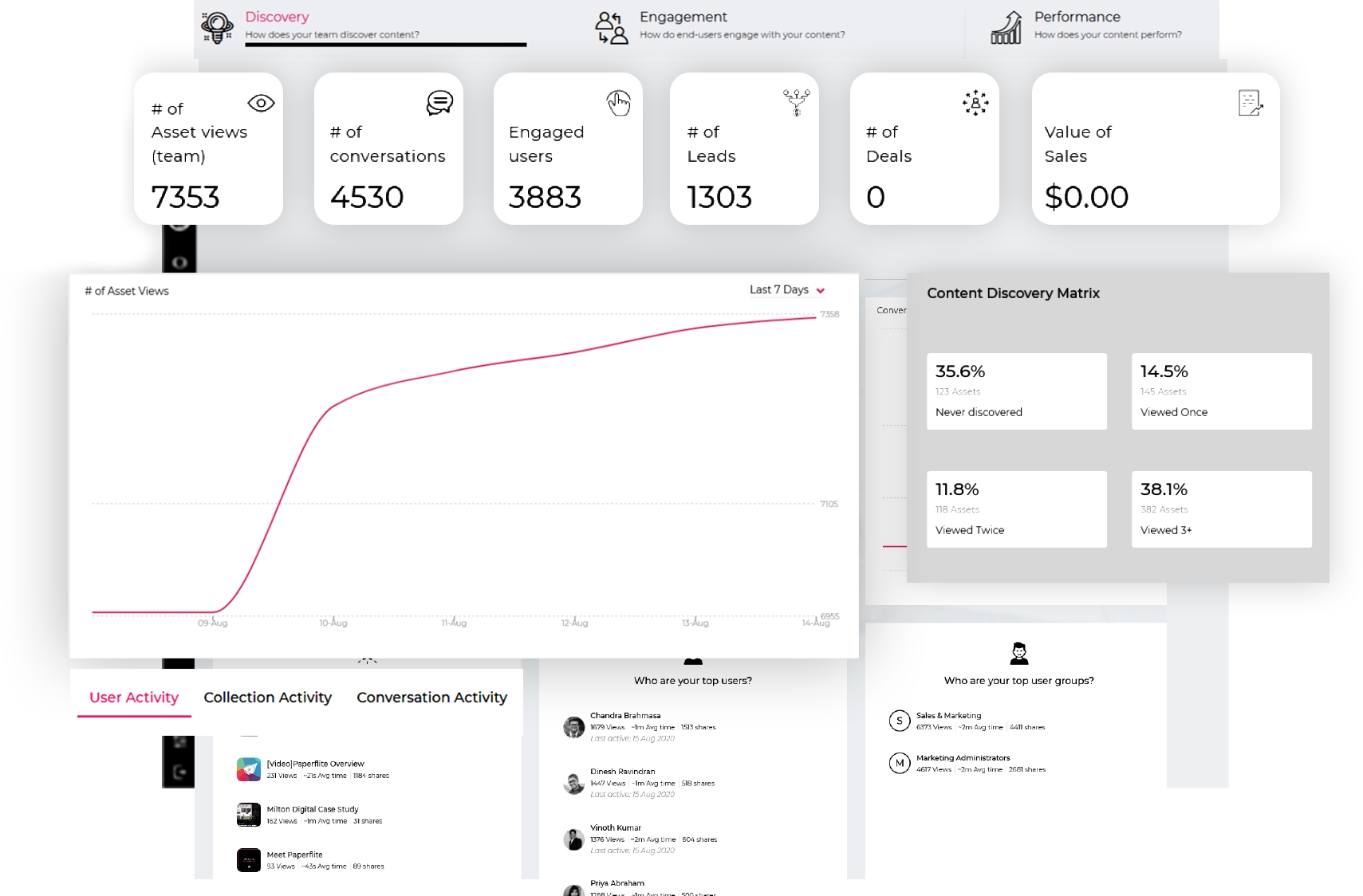
Failure to Increase Sales Effectiveness
Sales reps need the ability to reach more prospects and customers and deliver superior experiences through content personalization and insights into buyer intent. The impact of deep insights to create hyper-personalized content experiences is more vital
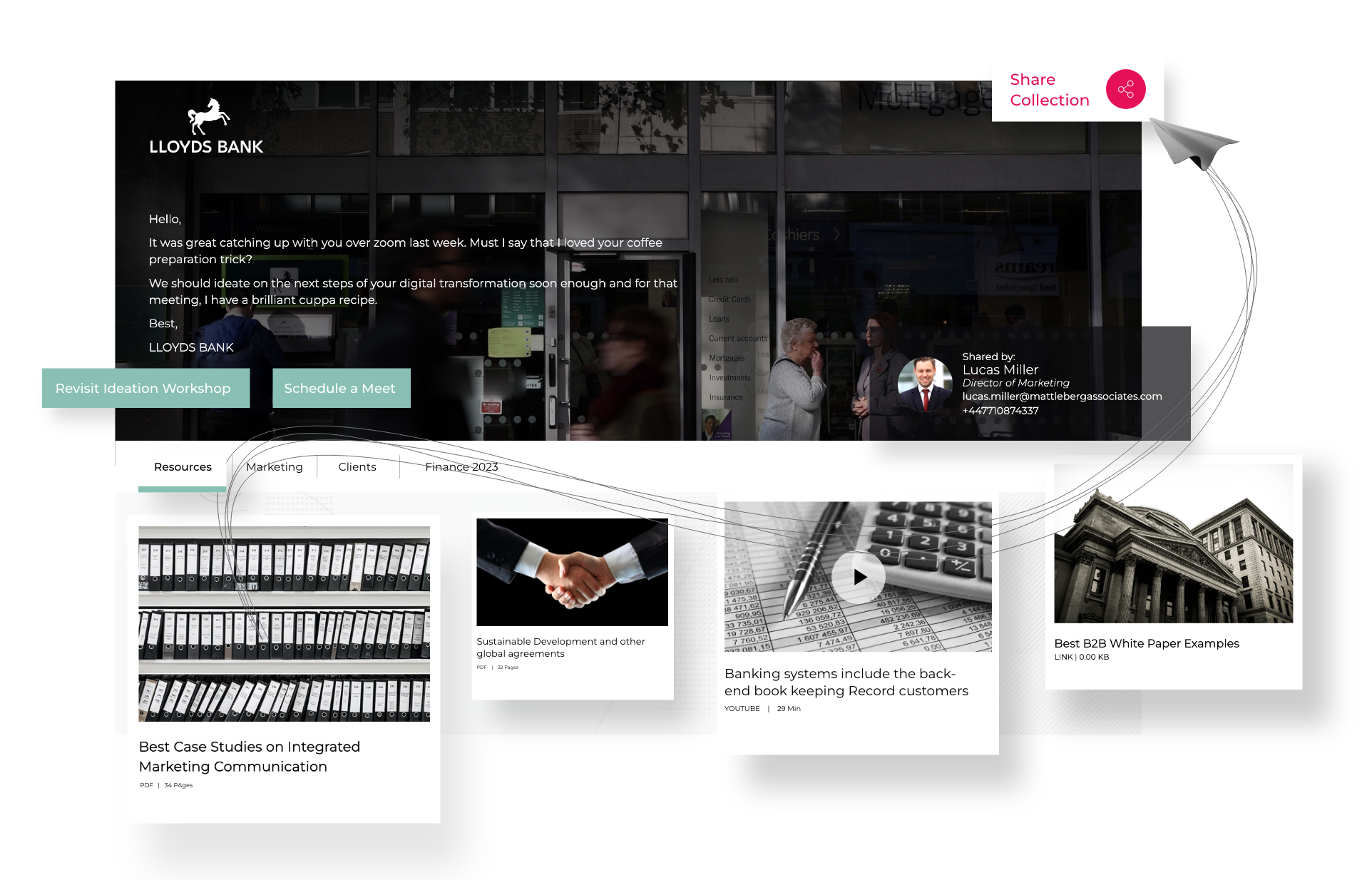
Inability to Drive Stronger Customer Engagement
Two major reasons that lead to sales reps being unable to drive stronger customer engagement are because:
-
Sales reps were unable to connect their product offerings to client business issues.
- And most of the time of sales reps are spend doing non sales activities
The first issue can be sorted by either providing extensive sales training to enhance skill still it will be difficult to track if the training had be fruit full or one could simply create focused sales enablement collateral that exactly matches the offerings of the product to the client’s requirements which in turn drives stronger buyer engagement, simplifies the buyer's journey, and reduces the burden on sales leaders to invest in sales rep training.
The second issue can be sorted by making the discovery of the content easier by using the right information at the right time sales reps create and this can be put into effect by having an effective content management system in place that empowers the latter to easily access and deliver the right content at the right time to the right prospect. This synergy enables the company's sales and marketing teams to operate in perfect harmony, maximizing their effectiveness.
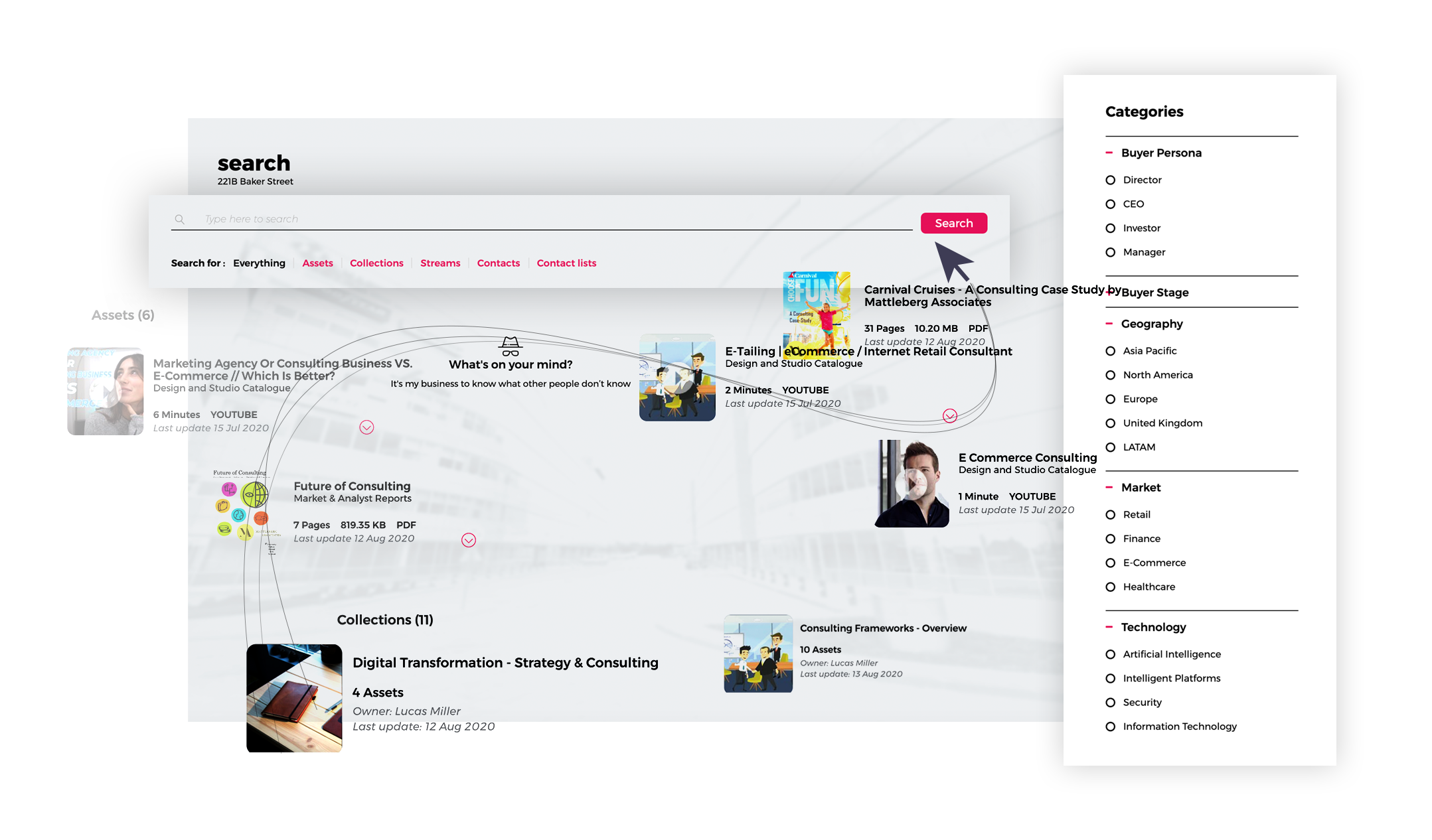
Types of Sales Enablement Content
Sales enablement content can be Broadly be classified into two major types, Internal and External Sales Enablement Content. Let's see what both entail.
Internal Sales Enablement Content
Internal Sales Enablement Content is designed to help sales teams learn, train, and collaborate. It is used to improve team knowledge, enable effective training, and promote internal communication and alignment.
Examples include : internal playbooks, training manuals, sales process documents, sales script, and sales email template
External Sales Enablement Content
External Sales Enablement Content is intended to help prospects and clients through the buyer's journey. It is useful in establishing brand authority, educating prospects, and helping the sales team engage and convert leads.
Examples include: case studies, product brochures, demo videos, whitepapers, and client testimonials.
There are diverse types of sales enablement content, ranging from compelling case studies and impactful product explainer videos to concise one-pagers and interactive sales presentations, all designed to empower sales teams and convert prospects. Lets understand in detail with examples:
1. White Papers
White papers are in-depth reports or guides that delve into a specific topic, offering detailed insights, analysis, and solutions. They are used to educate prospects, establish thought leadership, and provide valuable information to support decision-making.
For example, a company like IBM could publish a white paper on emerging trends in mobile tech, showcasing its industry knowledge.
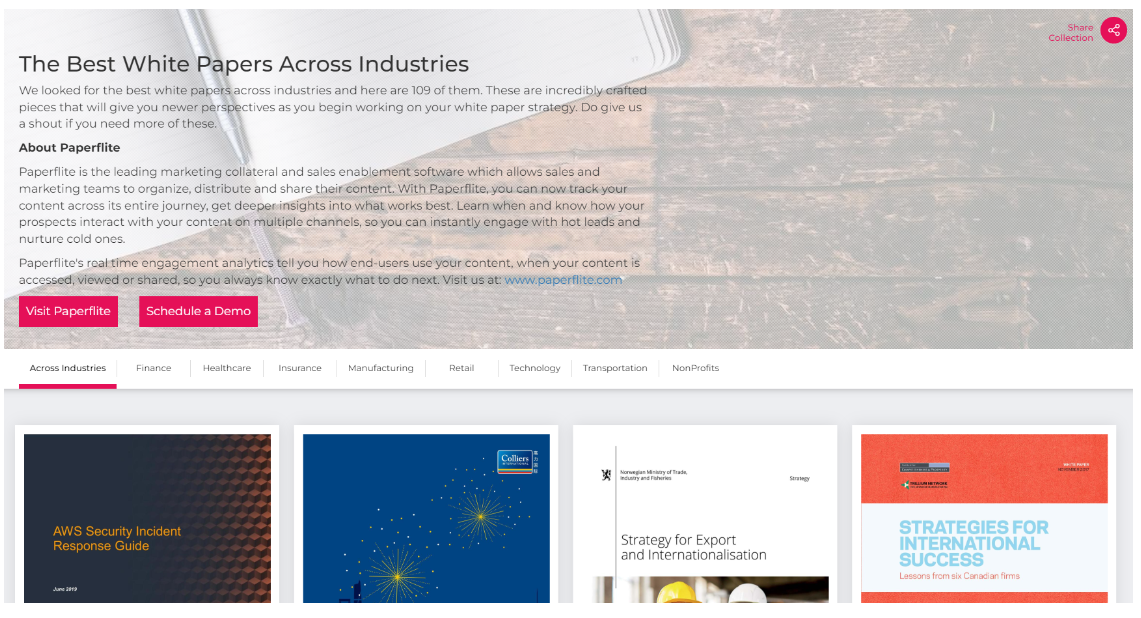
2. One-Pagers
These are concise documents summarizing key information about a product, service, or solution on a single page. They act as a quick reference tool for sales reps, providing a snapshot of essential details to share with prospects.
HubSpot uses one-pagers to highlight the key features and benefits of their latest offerings. Here is a template of one pager offered by HubSpot:
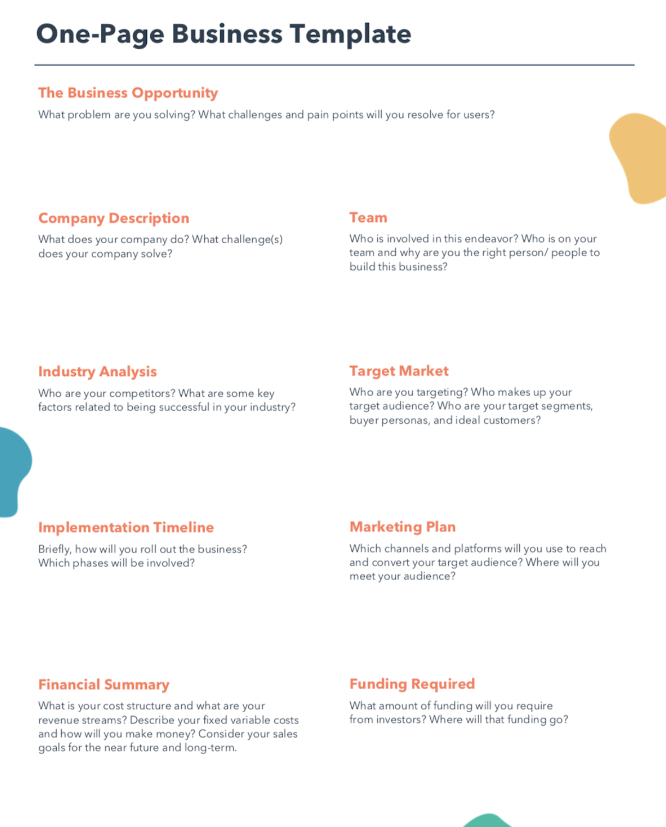
3. Case Studies
Case Studies are detailed narratives that showcase how a product or service solved a specific problem or delivered notable results for a customer. They validate a product's efficiency by illustrating real-world success stories, serving as a persuasive sales tool.
Paperflite uses case studies demonstrating how they significantly increased a client's online engagement and revenue.
Here is an example of one of our interactive case study.

4. Sales Presentations
These are carefully curated dynamic visual presentations created to convey key information and persuade prospects during sales meetings. Sales presentations guide the sales conversation, highlighting key benefits, and engaging prospects through visual storytelling.
Salesforce uses presentations to showcase product features, benefits, and successful use cases during client meetings.
5. Sales Battle Cards
Sales Battle Cards are quick-reference documents that help sales teams understand rivals, significant differentiators, and objection-handling methods. They are used in helping sales professionals traverse competitive landscapes and effectively overcome objections during sales calls.
For example, Microsoft designs battle cards comparing its features and pricing against those of competitors.
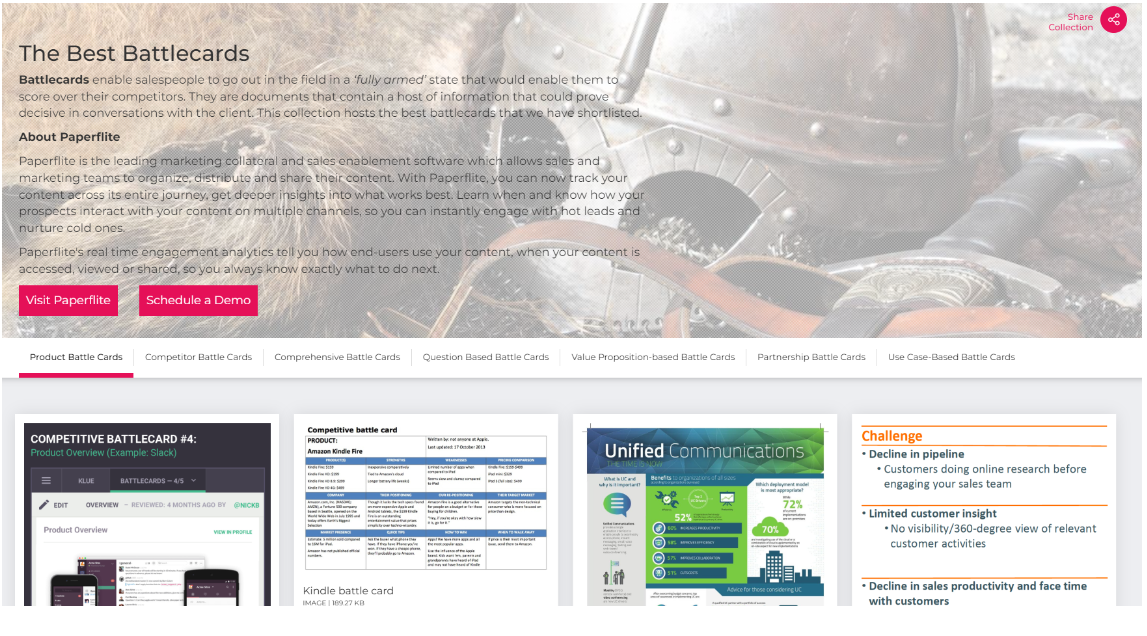
6. Testimonials
Testimonials are satisfied customer endorsements or recommendations that emphasize positive product or service experiences. They are useful in increasing credibility, developing trust, and acting as social evidence to persuade prospective purchasers.
For instance, Airbnb's website includes testimonials from clients who saw considerable efficiency benefits.
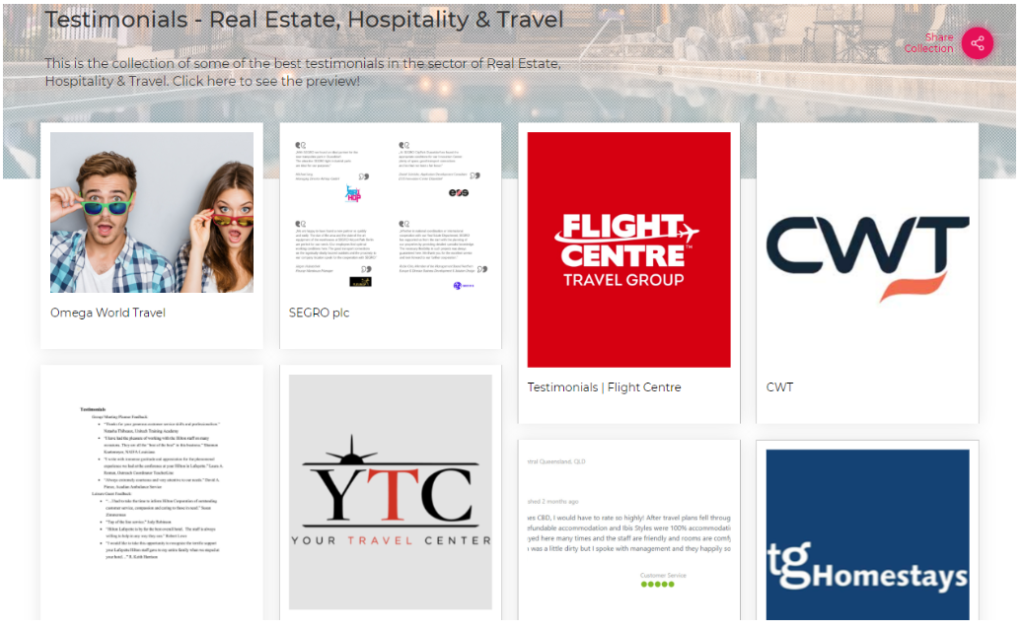
7. Sales Emails Templates
These are pre-written email content tailored to different phases of the sales process, providing consistency and efficiency in communication. Sales email templates are used by sales representatives to initiate and facilitate communication with prospects, providing a structured and efficient way to convey information, answer queries, and nurture leads.
Outreach uses a library of templates to streamline and personalize their email network, enhancing the efficiency of their sales communication strategies.
8. Product Explainer Videos
Product Explainer Videos are short videos that demonstrate the features, advantages, and applications of a product or service. They function by engaging prospects visually, simplifying complicated material, and improving comprehension.
A good example would be Adobe Marketing Cloud's video named 'Click, baby, click' which used humor to good effect. The video funnily portrays how a CEO and his company gets excited to see a sudden spike in orders for their product - encyclopedias. It is later revealed that it was the handiwork of a baby placing orders on a tablet.

9. Sales scripts
Sales scripts are organized guides that outline essential themes, questions and replies to utilize during sales encounters. Sales scripts are used as tools to assist sales representatives in maintaining a clear and effective communication strategy during sales interactions with prospects.
During sales contacts, Zendesk provides its sales staff with well-constructed scripts to facilitate talks that address frequently asked concerns by prospects.
10. Resource Hubs
These are centralized repositories for different sales-related assets, including manuals, instructions, and templates. Resource hubs function as a one-stop shop for sales teams to access, organize, and exchange essential materials.
Intercom provides its sales and customer support teams with invaluable insights and information by providing a single center with an abundance of materials, such as webinars and articles.
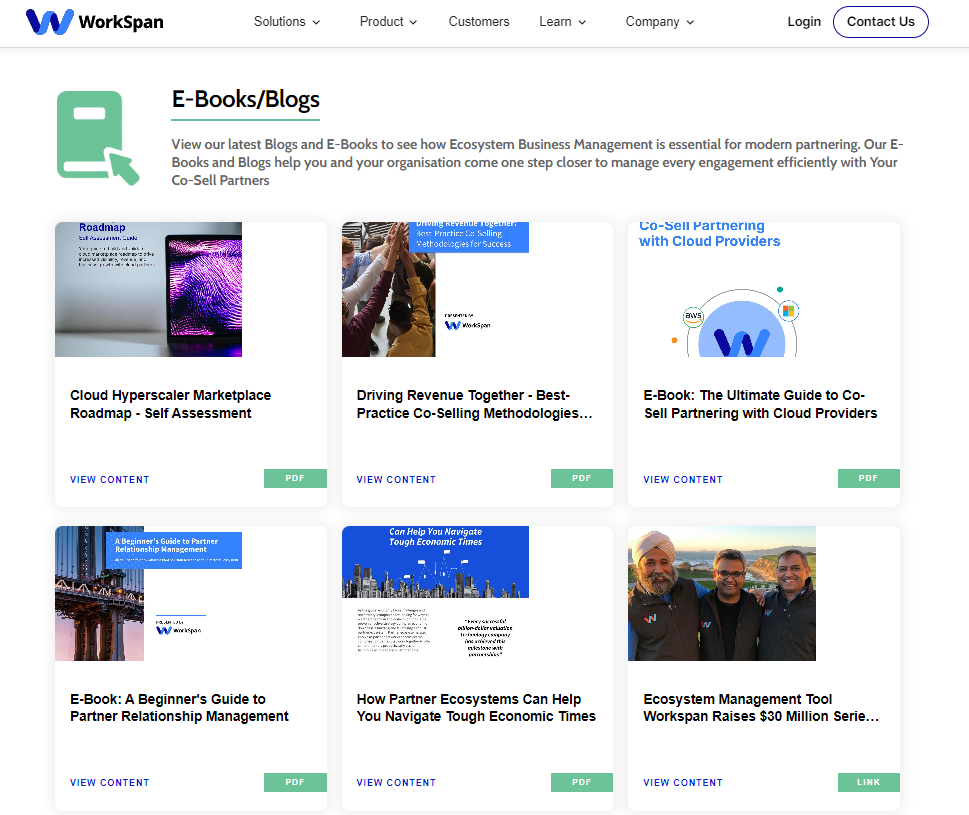
11. Pre-Sales Calls Checklist
These are a methodical set of actions and preparations to be performed before making a sales call to a prospect. It's used to enable detailed pre-call planning, allowing sales professionals to be well-prepared and focused during talks.
Sales personnel at Zoom Video Communications are provided with extensive checklists covering all necessary pre-call preparations, which guarantees a structured approach before speaking with potential customers.
12. Sales Training Materials
These are educational materials meant to teach sales teams about various elements of products, services, and effective selling strategies. They are used to enhance sales skills, product knowledge, and a grasp of sales procedures.
Oracle emphasizes lifelong learning for its sales professionals. To this end, the company offers comprehensive training resources that encompass sales strategies and industry trends.
13. Competitor Research Materials
Competitor research materials comprise gathered information about company rivals to identify their strengths, weaknesses, and market positioning. They are used in helping sales teams differentiate their offers, answer competition objections, and shape strategic positioning.
To gain insight into consumer trends, market dynamics, and the competitive landscape and to guide its strategic choices and product positioning within the technology sector, Apple engages in thorough competitor analysis.
Why is sales enablement content needed?
Sales enablement content is critical for empowering sales teams by providing them with the skills they need to navigate the complicated sales market successfully. It enables sales teams in:
1. Streamlining Communication: It ensures a consistent and clear message, which reduces uncertainty when communicating with prospects.
2. Enhancing Product Knowledge: Sales enablement content provides sales representatives with detailed product information, improving their confidence and trustworthiness.
3. Accelerating Onboarding: It helps provide consolidated training materials to help new sales team members get up to speed faster.
4. Facilitating Personalization: Content can be tailored to specific prospects' needs, resulting in more customized and meaningful interactions.
5. Improving Sales Productivity: Sales enablement content increases efficiency by making materials easily available, reducing time spent looking for relevant content.
How to organize sales enablement content
Creating good sales enablement content is only half of the game; the other half is organizing and ensuring that sales personnel can easily access it when required. The significance of content organization cannot be emphasized, since it directly influences sales efficiency and effectiveness. According to recent statistics, organizations that use well-organized content management saw a 25% improvement in sales close rates.
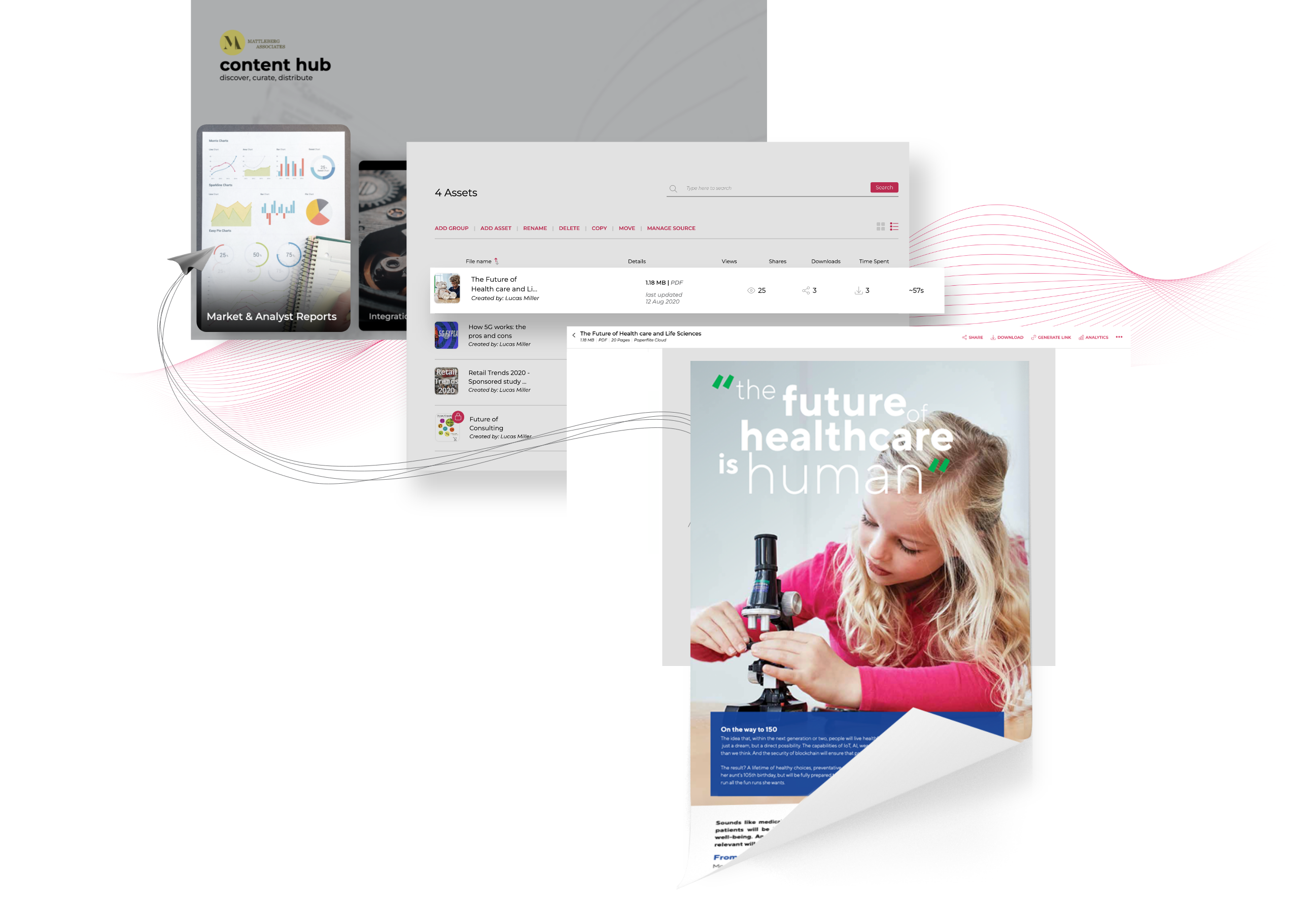
Using effective content management tools improves the structure and accessibility of sales enablement information. Now, let's look at some crucial pointers for excellent content organization:
1. Clear Metatags: Add descriptive metadata to each piece of content, such as keywords, subjects, and target audience, for easy searchability.
2. Creating a Content Map: Create a visual map of the content hierarchy and linkages. This helps in understanding how various components fit into the broader sales process.
3. Regular Update and Version Control: Keep your content up to date with changes in goods, services, or market dynamics. Maintain version control to prevent misunderstanding.
4. Implement a user access hierarchy by role: This ensures salespeople have access to appropriate material.
5. Easy Searchability: Create a user-friendly search experience to help sales reps rapidly identify relevant material using keywords or filters.
6. Content Distribution: Use a content management system to easily send updated materials to the sales team, ensuring everyone has access to the most recent information.
Let the Sellers Spend Time Selling not Searching
How to create sales enablement content
There are certain essentials for creating impactful sales enablement content, from aligning with sales goals to utilizing content management tools for interactive design and tracking engagement metrics. That said, let's first of all examine the sources from which you can create great sales enablement content.
Source for Creating Sales Enablement Content
Competitor Analysis
Conduct detailed competitor analysis to discover strengths, weaknesses, and unique selling features. This will influence content production for competitive positioning.
Third-Party Reviews and Industry Reports
Use external reviews and reports to extract useful data and consumer feelings, which may be included in content for credibility and market insight.
Sales Rep Insights
Leverage sales reps' knowledge of client pain areas, objections, and effective sales methods to create relevant material for prospects.
Customer Call Recordings
Understand real-world discussions, objections, and inquiries to create material tailored to particular customer concerns.
Product Documentation
Use detailed documentation to discover essential features, use cases, and technical information, turning them into digestible text for salespeople and potential customers.
Internal Knowledge Base
Utilize the organization's aggregate knowledge by creating an internal knowledge base with information that aligns with corporate expertise, policies, and values.
Creating sales enablement content
To get the intended sales outcomes, sales enablement content needs to be interactive, tailored to your prospects, and engaging. The entire process takes significant time and skill. Thankfully, there are great tools on hand to create such content for you.
Cleverstory significantly improves the efficiency of content development. It comes with interactive components to make charts and graphs more visually appealing while also allowing users to interact with data.
The platform provides easy navigation with clickable buttons that provide further information, unambiguous calls-to-action (CTA), and hyper-personalized designs. More so, it allows for the measurement of engagement and performance data, which provides insights into how the material connects with the audience.
To Make Content That is Bingeable and Not Boring
Sales Enablement Content Strategy
A sales enablement strategy is important for effectively using sales enablement content. Without it, one should only expect low or haphazard sales results. To create a great content strategy, you would need to pay attention to some key factors.
1. Goals and Objectives: Define the aims and objectives of the sales enablement content strategy, ensuring that they are aligned with broader company objectives such as raising sales conversion rates, improving product understanding, and increasing customer engagement.
2. Target Audience: Determine the target audience for sales enablement material, including internal stakeholders teams and external audiences like prospects and customers. Tailor information to their specific needs, problems, and interests.
3. Content Types: Determine which sorts of content will be most successful in attaining your goals. This could include product manuals, case studies, videos, and presentations. Provide a range of material forms to accommodate different learning styles.
4. Content Sources: Identify sources for obtaining useful and trustworthy material. This could involve internal resources like product documentation, competition research, and insights from sales reps, as well as external sources like industry studies and third-party evaluations.
5. Distribution Channel: Determine how the material will be disseminated. Choose channels that are appropriate for the target audience's interests and habits, whether through a centralized content management system, email, or other platforms.
6. Measurement and Metrics: Create key performance indicators (KPIs) to assess the effectiveness of the sales enablement content strategy. Metrics may include engagement rates, conversion rates, and the influence on sales funnel advancement. Analyzing data regularly allows for making educated modifications.
7. Roles and Responsibilities: Clearly define the roles and responsibilities of each team participating in the content strategy. Marketing teams are often responsible for content generation, while sales teams are in charge of distribution and use. Establish clear communication routes and cooperation points across teams to facilitate flawless implementation.
Sales Enablement Content Best Practices
Quality over Quantity
Instead of bombarding the target audience with content, focus on generating effective items that engage with them.
Alignment with Sales Goals
Every piece of content should add to the overall goal of increasing conversions, customer satisfaction, or other specified sales outcomes.
Customization
Tailor content to meet the requirements and tastes of your target audience. Personalization increases engagement and relevance, making content more successful in supporting sales efforts.
Accessibility
Ensure content is easily available for sales teams. Use content management systems and technologies that allow for easy access, dissemination, and changes, ensuring that representatives can discover and utilize the content effectively.
Compliance and Legal Considerations
Follow compliance and legal requirements, particularly in regulated sectors. To prevent legal ramifications, be sure that all information is in line with industry standards, legislation, and corporate rules.
Training and Education:
Educate sales teams on how to properly use and use sales enablement information. Provide your team members with the information and abilities necessary to find, understand, and apply the curriculum in a variety of sales circumstances.
Analytics and Optimization
Use analytics tools to track sales enablement content performance. Analyze engagement metrics, conversion rates, and other pertinent data regularly to optimize content strategy and ensure continual progress.
FAQs
1. What is sales enablement content?
Sales enablement content is strategic material that equips sales teams with resources, tools, and knowledge to engage and convert prospects throughout the sales process.
2. Who is a sales enablement content manager?
A sales enablement content manager is an individual responsible for the production, management, and distribution of sales-related information. They ensure that content is aligned with sales objectives and successfully help the sales team.
3. What is sales enablement content vs content marketing?
Sales enablement content focuses on providing resources for sales teams to engage prospects, whereas content marketing aims to raise awareness and attract a larger audience to create leads.
4. What types of sales enablement content should be prioritized?
Prioritize material like as one-pagers, case studies, and product explainer films. These materials provide brief, powerful information that helps salespeople engage and persuade prospects successfully.
5. What metrics should be tracked?
Monitor engagement rates, conversion rates, and pipeline progression. These metrics give information on the efficacy of sales enablement materials in achieving intended sales outcomes.
Leaving this here:
We have discussed what sales enablement content is, what it entails, and all you need to create effective sales enablement content for growth.
It doesn't end there though; To maximise your sales content approach, you'll need to review performance indicators, align with the sales process, change content based on new data, adjust to market conditions and refine content strategies over time. As you do this, you'll experience more engagement, higher conversion rates, and better sales effectiveness.
